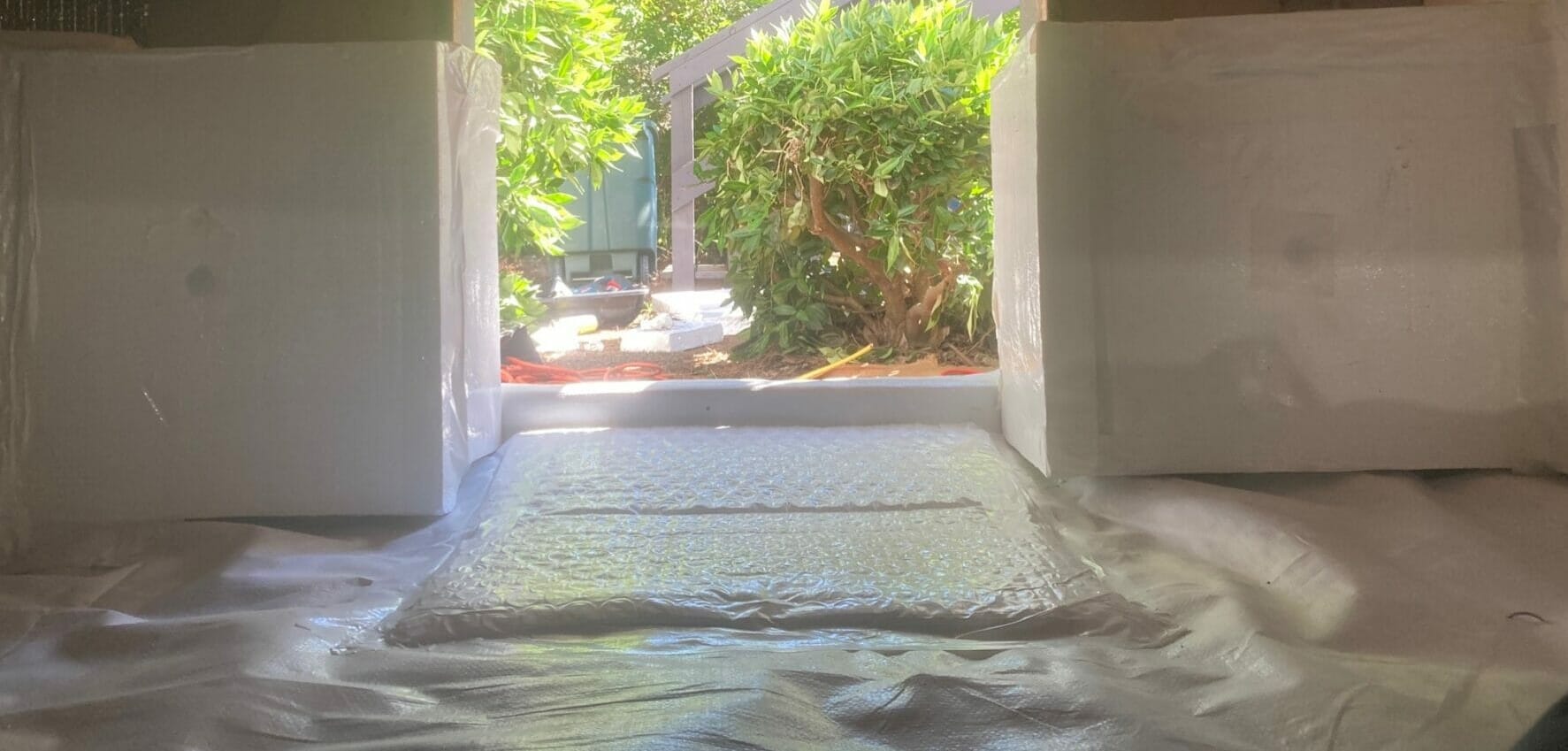Waterproofing is an important but often overlooked component of our homes and buildings. It’s a complex process that uses different materials and methods to protect our spaces from water damage. We’ll look at the basics of waterproofing, as well as various techniques used to prevent leaks and seepage.
Different materials are used in waterproofing, each with its own special properties that contribute to creating a watertight barrier. We’ll also discuss the importance of your home’s crawlspace in preventing water damage.
We’ll guide you on how to assess the health of your foundation and identify early signs of trouble. We’ll also share specific strategies for different types of foundations, as there’s no one-size-fits-all solution in waterproofing. Lastly, we’ll provide tips on maintaining your waterproofing to ensure its longevity.
By the end of this, you’ll be equipped with the knowledge to handle any waterproofing challenge confidently.
Understanding the Basics of Waterproofing
Think of waterproofing your home like sealing a ship to keep it from sinking. Your house needs to be protected from water to maintain its structure.
Waterproofing materials
Successful waterproofing depends on the right materials. Different substances such as liquid-based membranes, rolled sheets, and concrete-like finishes are used to block water. Each material has unique features that make it suitable for certain situations. For example, liquid membranes are flexible and can cover uneven surfaces, sheet membranes provide strong protection but need careful installation, and cementitious coatings are easy to apply and long-lasting.
This guide will give you all the information you need to choose the best waterproofing material for your needs.
Importance of Crawlspace in Home Waterproofing
Even though your crawlspace might be hidden, it plays a crucial role in waterproofing your home. A wet crawlspace can cause mold growth, wood decay, and even affect the air quality inside your house.
Materials Used in Waterproofing
Waterproofing relies on specific materials to keep water out. Let’s talk about some of the most effective ones.
Silicone Sealants
Silicone sealants are excellent at resisting water. They are flexible and can adjust with your building’s movements, preventing cracks from becoming leaks. They are perfect for sealing gaps near windows or entrances because they can fit any structure. Silicone sealants can withstand various weather conditions, making them useful both indoors and outside.
Cementitious Coatings
Cementitious coatings are strong waterproofing materials. They combine cement with other substances to create a strong barrier against water. You can apply them directly to surfaces like concrete walls or floors to prevent water damage. However, they are less flexible than silicone sealants, so they’re best used in areas that don’t require much movement.
The Role of Crawlspace in Home Waterproofing
Think of your home’s crawlspace as the unsung hero in the battle against water damage. This often-overlooked area plays a pivotal role in maintaining your house’s structural integrity and overall health.
At Impact Crawlspace LLC, we’ve seen firsthand how a well-maintained crawlspace can mean the difference between a dry, comfortable home and one plagued by moisture issues. Water has a sneaky way of finding its path into any space given half a chance, making an unprotected crawlspace ground zero for intrusion.
We’ve devised multiple tactics, from simple to sophisticated, aimed at repelling water effectively. These include installing high-quality vapor barriers that act like raincoats for your foundation walls and floors. But it doesn’t stop there; proper drainage systems are also critical to direct water away from the foundation effectively. When combined with dehumidifiers to control air moisture levels, these methods create an environment where mold simply cannot thrive.
Mold transcends being merely a blemish on your wall, transforming into a significant hazard to one’s health. That’s why keeping crawlspaces dry isn’t just about protecting buildings—it’s about safeguarding families as well.
Assessing Your Foundation’s Waterproofing Needs
Wonder why your basement feels more like a swamp than part of your home? It might be time to check your foundation’s waterproofing.
Understanding Signs of Water Damage
Sometimes, water damage waves a red flag; other times, it’s sneakier. Keep an eye out for flaking paint, a musty smell, and walls that look bent out of shape. These are clear SOS signals from your foundation. And when mold starts making an appearance? That’s not just bad news; that’s a health hazard knocking on wood.
If you spot cracks wider than a credit card in your foundation walls, don’t wait around. These crevices go beyond mere eyesores; they beckon moisture to infiltrate with open arms.
Finding the Right Solution
No two foundations are alike, which means there isn’t a one-size-fits-all solution to waterproofing woes. Whether it involves sealing those pesky cracks, getting sump pumps installed or embracing full-scale external waterproofing methods depends on what we find down under—literally.
Picking between interior versus exterior waterproofing is another story altogether but fret not. Impact Crawlspace LLC has seen it all and fixed even more. We’ll guide you through choosing the best option tailored specifically to keep dryness in and dampness out of your sanctuary below ground level.
Waterproofing Techniques for Different Foundation Types
Different foundation types require different waterproofing strategies. Here’s how we handle them at Impact Crawlspace LLC.
Concrete Slab Foundations
For concrete slabs, our strategy is to create a barrier using sealants and membranes that prevent moisture from getting in. It’s like putting a water-resistant coat on your foundation. This method is not only effective but also durable. With our professional installation, you can rest assured that your home will be protected from water damage for years.
Crawlspace Foundations
Crawlspaces can be challenging, but with the right approach, they’re manageable. We usually use encapsulation to make your crawlspace dry and clean. You could even use it for storage if you want. To control humidity levels, we recommend installing a dehumidifier. This way, you won’t have to worry about dampness or mold.
Basement Foundations
Basements need a strong waterproofing strategy because they’re exposed to moisture from both inside and outside. Our strategy involves using interior drainage systems and sump pumps to quickly remove any water that gets in. We also apply exterior waterproof coatings for added protection. With our approach, basements don’t have to be unpleasant, damp spaces.
The Process of Professional Waterproofing Installation
Ensuring your living space remains moisture-free and fortified against leaks, enlisting the expertise of a professional waterproofing service is indispensable. At Impact Crawlspace LLC, we’ve mastered the art of sealing homes from unwanted moisture.
Understanding the Basics of Waterproofing
Waterproofing isn’t just slapping some sealant around and calling it a day. Crafting this barrier involves a meticulous process to ensure not even a drop of water can seep through. Kicking things off, we meticulously examine your base to pinpoint any potential weak spots that could allow water to infiltrate.
Embarking on this journey, we meticulously examine your abode’s foundation to unearth any distinct obstacles it might harbor. Whether it’s cracks in the foundation or poor drainage around the property, identifying these issues early lets us tailor our approach effectively.
Materials Used in Waterproofing
Selecting the right materials is next on our agenda. From liquid membranes to sheet-based barriers, we use only top-quality products designed for long-lasting protection against moisture intrusion.
Our selection process for materials hinges on their robustness, pliability, and the effectiveness of their bond to varied textures. This ensures that no matter what type of foundation you have—be it concrete block or poured concrete—we have an effective solution ready.
Benefits of Investing in Quality Waterproofing
The Shield Against Structural Damage
Dampness is the arch-nemesis of any structure. Gradually, moisture infiltration might erode the very bedrock of buildings, leading to fissures and potentially catastrophic failures. But with top-notch waterproofing, your home stands firm, repelling water like a champ.
This isn’t just talk. Research has illustrated that adept waterproofing substantially augments a building’s longevity, thwarting the intrusion of moisture which can precipitate structural deterioration.
Mold Growth: Not on Our Watch
Besides being unsightly, mold poses serious health risks – from allergies to chronic respiratory conditions. A well-executed waterproof barrier keeps moisture out and prevents mold spores from finding their happy place in your walls or floors.
Avoidance is key here because once mold takes hold, eradication can be costly and never 100% guaranteed.
Breathe Easy with Improved Air Quality
Last but certainly not least, damp-free homes mean cleaner air indoors. Moist environments are breeding grounds for dust mites and other allergens but keeping things dry with solid waterproofing measures means these unwelcome guests won’t settle down in your space.
Maintenance and Upkeep of Waterproofed Structures
So, you’ve got your home all waterproofed up. Nice move. But remember, like a car that needs its oil changed, waterproofed areas need some TLC to keep them in top shape.
Routine checks are your best friend here. A quick look-see around your basement or crawlspace every few months can save you from headaches later on. Look out for any signs of moisture or leaks because even the best waterproofing jobs can face challenges over time.
But what if you spot something amiss? That’s when it’s time to call in the pros. Companies like Impact Crawlspace LLC, with their expertise in everything from mold remediation to foundation repair, know exactly how to fix issues before they turn into bigger problems. Don’t wait until it’s too late; regular maintenance combined with professional assessments is key to ensuring the longevity and effectiveness of your waterproofing efforts.
Conclusion
Thus, we plunged into the mysteries of waterproofing to grasp its mechanics. We’ve seen that materials and methods matter. They’re your first line of defense against moisture.
We talked about crawlspace care, because out of sight shouldn’t mean out of mind. This spot plays a big role in keeping homes dry.
We covered assessing foundation health. Spotting issues early can save you a world of trouble later on.
And we looked at different strategies for various foundations. Because fitting square pegs into round holes just doesn’t cut it here.
Following that, we dove into essential upkeep advice, a cornerstone in safeguarding your space from the relentless threat of water harm. Consistently inspecting your space is vital to keep it shielded from any leaks.
To wrap up, remember that understanding the basics puts power in your hands—power to protect and preserve your space from unwanted water intrusion effectively.

